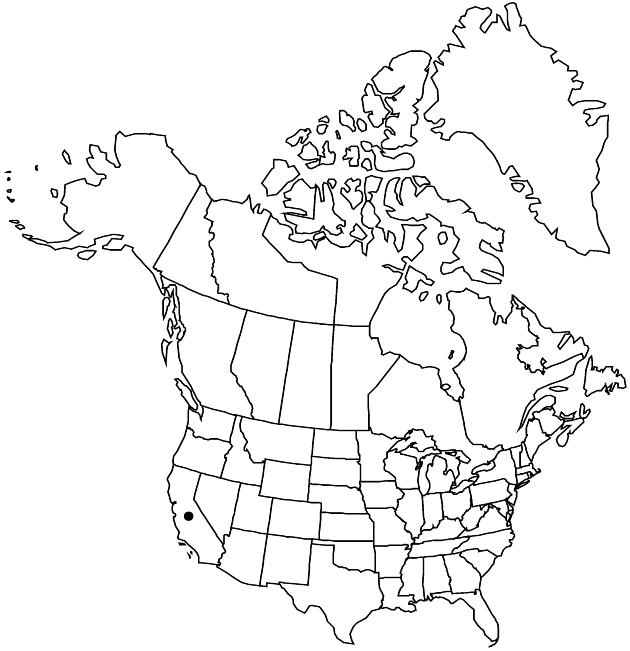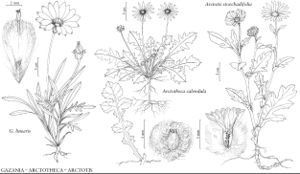Difference between revisions of "Arctotheca calendula"
J. S. African Bot. 8: 284. 1942.
FNA>Volume Importer |
imported>Volume Importer |
||
| (3 intermediate revisions by 2 users not shown) | |||
| Line 6: | Line 6: | ||
|place=8: 284. 1942 | |place=8: 284. 1942 | ||
|year=1942 | |year=1942 | ||
| + | }} | ||
| + | |special_status={{Treatment/ID/Special_status | ||
| + | |code=W | ||
| + | |label=Weedy | ||
| + | }}{{Treatment/ID/Special_status | ||
| + | |code=I | ||
| + | |label=Introduced | ||
| + | }}{{Treatment/ID/Special_status | ||
| + | |code=F | ||
| + | |label=Illustrated | ||
}} | }} | ||
|basionyms={{Treatment/ID/Basionym | |basionyms={{Treatment/ID/Basionym | ||
|name=Arctotis calendula | |name=Arctotis calendula | ||
|authority=Linnaeus | |authority=Linnaeus | ||
| + | |rank=species | ||
|publication_title=Sp. Pl. | |publication_title=Sp. Pl. | ||
|publication_place=2: 922. 1753 | |publication_place=2: 922. 1753 | ||
| Line 16: | Line 27: | ||
|name=Cryptostemma calendula | |name=Cryptostemma calendula | ||
|authority=(Linnaeus) Druce | |authority=(Linnaeus) Druce | ||
| + | |rank=species | ||
}} | }} | ||
|hierarchy=Asteraceae;Asteraceae tribe Arctotideae;Arctotheca;Arctotheca calendula | |hierarchy=Asteraceae;Asteraceae tribe Arctotideae;Arctotheca;Arctotheca calendula | ||
| Line 31: | Line 43: | ||
|elevation=0–300 m | |elevation=0–300 m | ||
|distribution=Calif.;Africa. | |distribution=Calif.;Africa. | ||
| + | |introduced=true | ||
|discussion=<p>Most populations of <i>Arctotheca calendula</i> are sterile and spread aggressively by stolons; at least three populations in the flora are fertile and highly invasive. The species is listed by the California Exotic Pest Plant Council (CalEPPC) as a weed with the potential to spread explosively (Red Alert, CDFA A).</p> | |discussion=<p>Most populations of <i>Arctotheca calendula</i> are sterile and spread aggressively by stolons; at least three populations in the flora are fertile and highly invasive. The species is listed by the California Exotic Pest Plant Council (CalEPPC) as a weed with the potential to spread explosively (Red Alert, CDFA A).</p> | ||
|tables= | |tables= | ||
| Line 40: | Line 53: | ||
-->{{#Taxon: | -->{{#Taxon: | ||
name=Arctotheca calendula | name=Arctotheca calendula | ||
| − | |||
|authority=(Linnaeus) Levyns | |authority=(Linnaeus) Levyns | ||
|rank=species | |rank=species | ||
| Line 55: | Line 67: | ||
|publication title=J. S. African Bot. | |publication title=J. S. African Bot. | ||
|publication year=1942 | |publication year=1942 | ||
| − | |special status= | + | |special status=Weedy;Introduced;Illustrated |
| − | |source xml=https:// | + | |source xml=https://bitbucket.org/aafc-mbb/fna-data-curation/src/2e0870ddd59836b60bcf96646a41e87ea5a5943a/coarse_grained_fna_xml/V19-20-21/V19_232.xml |
|tribe=Asteraceae tribe Arctotideae | |tribe=Asteraceae tribe Arctotideae | ||
|genus=Arctotheca | |genus=Arctotheca | ||
Latest revision as of 20:50, 5 November 2020
Plants usually stoloniferous. Leaves obovate, (2–)5–20(–30+) × (1–)2–5(–7) cm, margins pinnati-sect (lyrate to runcinate), remotely prickly, abaxial faces white-pannose, adaxial faces sparsely puberulent to arachnose, usually glandular as well. Heads 4–7 cm diam. (across the rays). Phyllaries: outer reflexed, apices mucronate, white-woolly; inner appressed, margins hyaline, apices rounded, glabrous. Ray florets 11–17(–25); corolla laminae abaxially greenish to purplish, adaxially yellow (drying to basally ochroleucous, apically blue, forming bull’s eye around disc), 10–25 × 2–4 mm, sparsely puberulent, glandular. Disc florets: corollas yellow proximally, bluish distally. Cypselae dark brown, 3 mm, densely woolly; pappi ca. 0.5 mm (usually hidden by hairs on cypselae).
Phenology: Flowering Oct–Aug.
Habitat: Roadsides, old fields, other disturbed habitats
Elevation: 0–300 m
Distribution

Introduced; Calif., Africa.
Discussion
Most populations of Arctotheca calendula are sterile and spread aggressively by stolons; at least three populations in the flora are fertile and highly invasive. The species is listed by the California Exotic Pest Plant Council (CalEPPC) as a weed with the potential to spread explosively (Red Alert, CDFA A).
Selected References
None.
